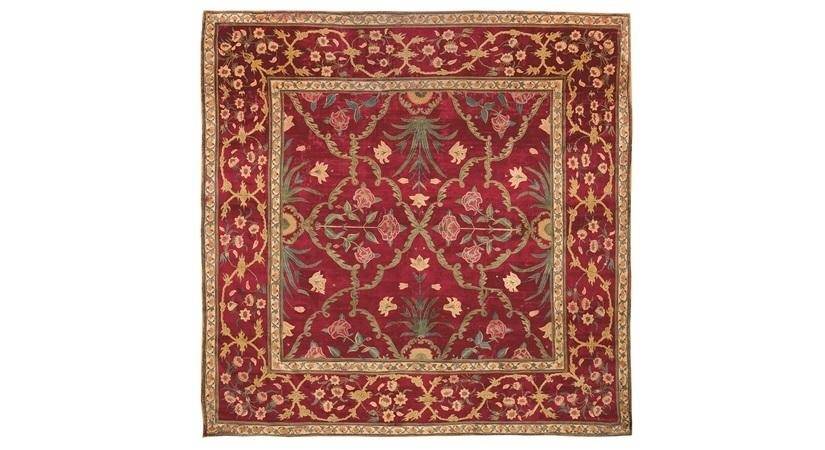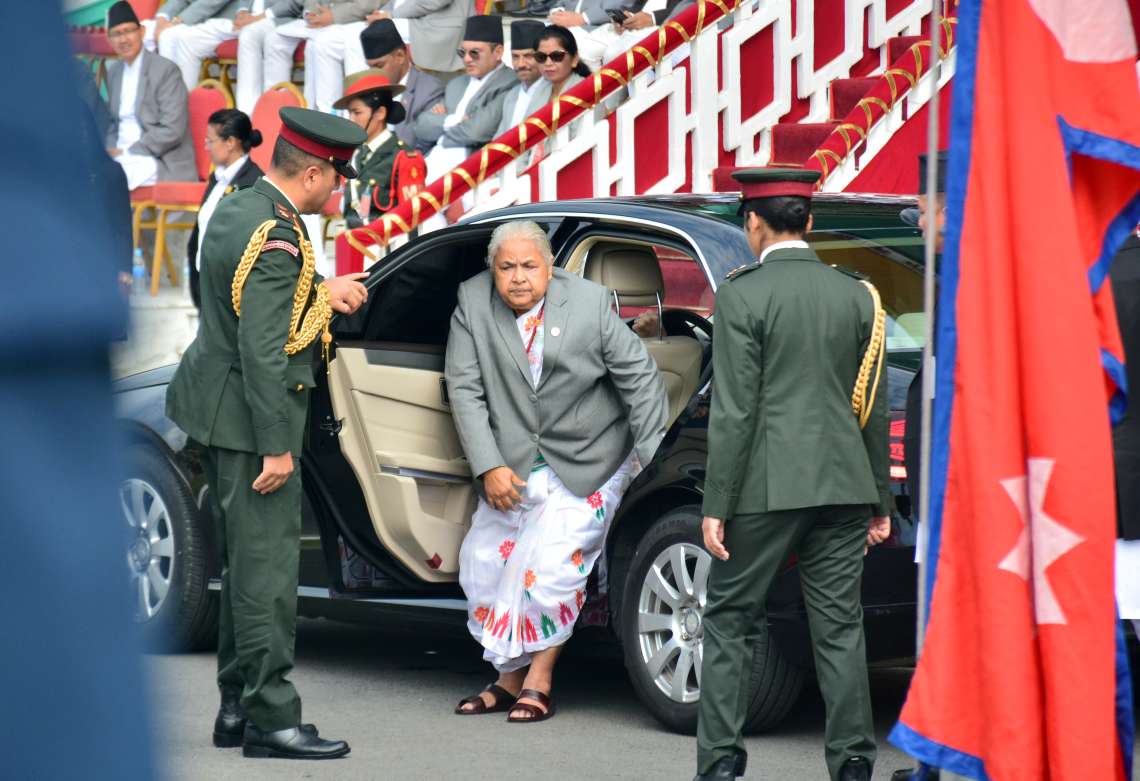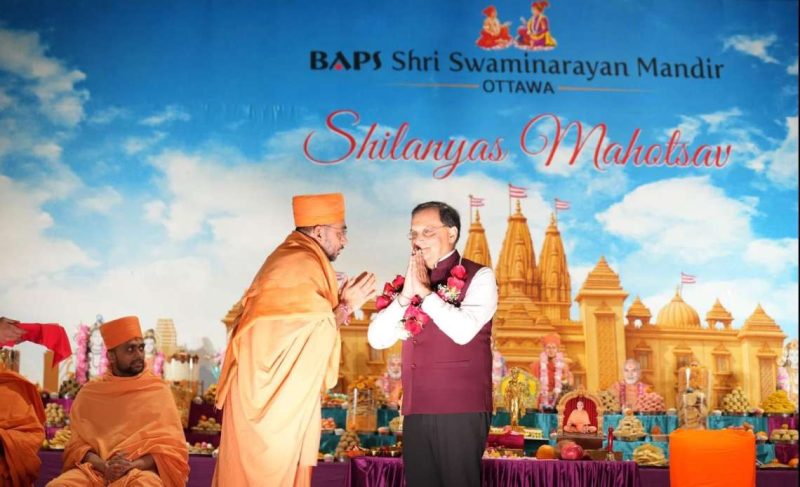The carpet offered here represents the highest level of production found at the Mughal court in the middle of the 17th century. …writes Daniel Walker
A rare Mughal Pashmina Carpet from Northern India, Kashmir or Lahore circa 1650 9ft. x 8ft. 11in. (275 x 274 cm.) will be up for auction at Christie’s upcoming Islamic and Indian Art. The Pashmina wool Warp is in green, white, red silk, Z2S, alternate moderately depressed with the weft in red silk, U, x 3 Knot count: 672 per sq. inch.
The carpet offered here represents the highest level of production found at the Mughal court in the middle of the 17th century. With knots of pashmina wool, fine goat hair traditionally used to weave shawls in Kashmir and Lahore, and a foundation of silk, the carpet consists of luxury materials. The weave is extremely fine, with about 672 knots per square inch. The field pattern involves an elaborate diamond lattice framework of leafy foliage which twists and coils at regular intervals. The lattice forms cartouche-like compartments containing single flowers-lilies (white), sunflowers (yellow), and possibly cockscomb (red, pink, and white) — shown in silhouette on a deep and brilliant wine-red ground.1 The main border design features a pattern of reciprocal vines whose curves embrace clusters of unidentified flower blossoms. These vines, also set against a red ground, incorporate little stylised cloud wisps derived from Chinese tradition. The main border is framed by identical minor borders consisting of a reciprocal vine bearing small blossoms and leaves. The fine weave allows for the presentation of minute naturalistic details, especially in the blossoms of the flowers, the lattice, and the vine scroll in the main border. The carpet is now virtually square but it has been shortened: the length was originally about 4.4 metres. Three smaller fragments in public and private collections are probably survivors of a prior campaign to excise areas of damage.
The Flower Style
The genesis of the flower style in Indian art can be traced to the visit of the Mughal emperor Jahangir (r. 1605-27) to Kashmir in 1620. Not known as an innovator or territorial expansionist or religious radical, Jahangir (The World Seizer) had the wisdom to maintain the tolerant approach and policies of his father Akbar, who had ruled successfully for fifty years. Akbar had been a great art patron and established royal carpet workshops during the last quarter of the 16th century. With the affairs of the state well in hand, Jahangir not only continued to support the arts, but he was also a true collector and a sensitive connoisseur as well. He had a special appreciation for the beautiful and the unusual, such as exotic animals, for example.
Jahangir had been to Kashmir before but not in the Spring when the flowers were in full bloom, and he recorded his enthusiasm in rich detail in his memoirs: “Kashmir is a garden of eternal spring, or an iron fort to a palace of kings – A delightful flower-bed, and a heart-expanding heritage for dervishes… Wherever the eye reaches, there are verdure and running water. The red rose, the violet, and the narcissus grow of themselves; in the fields, there are all kinds of flowers and all sorts of sweet-scented herbs more than be calculated. In the soul enchanting spring the hills and plains are filled with blossoms; the gate, the walls, the courts, and the roofs, are lighted up by the torches of banquet-adorning tulips….Thank God that on this occasion I beheld the beauties of spring.”
Jahangir goes on to identify particular flowers that were special for their colour or scent, including blue or white or sandalwood-coloured jessamines, red or light yellow roses, and two kinds of lilies, one grown in gardens, the other wild.
Jahangir was fascinated by the natural world surrounding him and tasked members of his painting workshop to record what he considered special or unusual. He was accompanied in Kashmir by his favorite natural history painter, Mansur, who on this trip produced more than 100 paintings of local flowers, of which three survive. These works were very influential and served as the basis for a new interest in flower “portraits”, treated much like the paintings of nobles, standing quite formally and set against a plain ground, that had been commissioned by Akbar. Mansur, stimulated by Jahangir’s powers of observation, placed a new emphasis on naturalistic representation. Jahangir provided the incentive for the new style but the visual model came from Europe, in the form of manuscripts or loose sheets of scientifically accurate representations of flowers known as herbals. These became very popular in Mughal court circles and workshops and were brought to India by clergymen and other European visitors. A generic connection can be seen in the formal poses of the plants, in the interest in naturalistic portrayal, in shading, and even in the provision of extra details such as butterflies or dragonflies fluttering nearby. This connection has been demonstrated very specifically by the discovery of a European herbal subject, dating from 1608 (first edition), and a Mughal copy, attributable to about 1635. 5 The flower style, thus initiated in paintings under the emperor Jahangir in the later years of his rule, did not become the dominant court style until the reigns of Shah Jahan (r. 1627 – 1658) and his son Aurangzeb (r. 1658 – 1707).
As the new ornamental style in architectural decoration and the decorative arts took hold, single flower “portraits” were given more elaborate forms. Naturalistic flowers were thus shown in profile in rows, combined with lattice patterns, or presented in a more abstract way as blossoms instead of flowers in profile.
After about 1630, the flower style largely (but not entirely) supplanted the previous style which had been favored at the Persian court. This Persian style consisted of two main varieties: one was a pictorial type dependent on the book illustration tradition, and the other involved patterns based on symmetrical networks of scrolling vines and palmettes and sometimes overlaid with animals or medallions. Although there are scattered references to carpet production in India in earlier times, it was under the rule of the emperor Akbar (r. 1556 – 1605) that court workshops for carpets were established, first at Fatehpur Sikri and Agra and later at Lahore and Kashmir. Commercial manufacture existed in parallel to court production. About 1590, Abul Fazl, Akbar’s chronicler, stresses how many weavers had settled in India and how active the trade in carpets had become. Although carpet production in India was now flourishing, demand for Persian carpets continued to be strong.8 But after about 1630 or so, the vast majority of court carpets woven in India reflected the new taste for the Flower Style.
Pashmina
In most rug-weaving cultures, silk is the most valuable and sumptuous fibre available and is thus the one typically employed for the pile of the highest grades of luxury carpets. In Mughal culture, in northern India, this was not the case. The most highly prized fibre for the pile, that part of the carpet one actually had physical contact with and sat or walked on, was not silk but goat hair, pashmina, the undercoat of the Himalayan mountain goat (Capra hircus laniger). The term pashmina derives from pashm, the generic Persian word for any kind of wool. It is also known as cashmere wool because it was associated with Kashmir, famous for its shawls made from this material. But Kashmir was not the source of the wool, it was merely the transfer point for the fibre collected from the mountainous areas surrounding Kashmir. The trade-in of this special, prized wool was controlled by the maharajah of Kashmir.
Carpets made with pashmina pile are among the finest carpets ever woven. The highest knot count exceeds 2,000 knots per inch., which goes beyond what the eye can “read”.10 The majority of examples fall between 400 and 1,000 knots per square inch; the carpet proposed here has an average of 672 knots per sq. inch. 17thcentury examples have silk foundations whose relative fineness, together with the fineness of the knots themselves, enable the weaver to achieve beautiful curved lines as well as highly naturalistic details. Some later pashmina rugs, which fall into a category with small-scale floral patterns (often called “millefleur”), show some relaxation of standards, with cotton appearing instead of silk in the foundation, resulting in a slightly coarser weave. Also, some later millefleur rugs have a pile of sheep wool, not pashmina. This brings up another point, namely that it is difficult if not impossible to distinguish by touching the wool pile of a fine sheep’s wool rug versus a “relatively” coarse pashmina pile.
The carpet proposed here has a pashmina pile and silk foundation. A classic feature of 17th century pashmina carpets is the grouping of warp threads into coloured stripes often visible in the end fringes, which are an extension of the warps. The coloured end fringes are missing in our carpet but they are visible as green, white, and red stripes under very close examination of the piled area, thus confirming that the proposed carpet does indeed belong to this prestigious group. The coloured stripes perhaps aided the weavers in terms of pattern registration or, more likely, the end fringes provided a colourful touch that appealed to the emperor’s personal taste.
Painting with Knots
The fineness of weave achievable with pashmina as the pile fibre, as well as the ability of the goat hair to yield beautifully saturated colours, led the Indian weavers to become masters of colour usage, to a degree more often associated with painters and illuminators. The juxtaposition of closely related colours without the separation deriving from outlines, a technique that might be described as “shading”, was occasionally used in a Persian context but was then given much more widespread treatment in India, especially in pashmina examples. Shading was used to provide a sculptural quality or three-dimensional effect, thus enhancing the naturalism as represented in imported European goods such as the herbals or engravings of ornamental panels. Shading is used to rich effect in the proposed carpet in the sequence of greens in the leafy lattice elements and the reds and pinks of the cockscomb (?) blossoms.
A second technique mastered by Indian weavers may be termed “colour mixing”, in which knots of two different colours, not necessarily related, are juxtaposed in checkerboard fashion, yielding a third colour. This also increases the naturalism but, even more importantly, it broadens the palette at the weaver’s disposal. Persian carpet-weavers liked to represent water in this way, juxtaposing blue and white knots to create a shimmering effect. It is given more widespread treatment in Indian carpets, even some made with more commonplace materials. The red petals of the cockscomb (?) blossoms in the proposed carpet show this technique very well, with an inner red zone created by mixing red and white and an outer zone of pink created by mixing pink and white. Each cockscomb (?) blossom has an exterior outline in black, but the colours of the interior components are allowed to merge without an outline.
Patterns
There are many extant examples of Indian carpets with flowers shown in silhouette. Some of these, of commercial grade, have flowers arranged in rows on plain ground. Typically, many of these rugs have a rectangular format while a significant number have a distinctive arch “cut-out” on one long side. A few are circular or polygonal in format. The purpose of these shaped carpets is not clear but a function as tent furnishings has been suggested.
During the course of Shah Jahan’s reign, various types of lattice constructions were introduced as an organising principle for flowers and also blossoms. Lattice designs could vary considerably. One carpet, represented by fragments in London and Dusseldorf, has flowers occupying ovoid compartments formed by serrated vines that meander back and forth. Some lattice designs, as in a fragment in the Keir Collection, may have been inspired by tile patterns.15 Other lattices were taken from European ornamental models based on classical revival themes of abundant vegetation (especially acanthus) and strapwork. Such designs became popular in India in architectural decoration, illuminations for manuscripts, and decorative arts in general. The orientation of the flowers in some examples was directional, that is, oriented in one direction, but, in some instances such as the proposed carpet, the orientation was radial. The patterns are found in both pashmina and the more common sheep’s wool carpets.
Lattice patterns were also conceived that employed blossoms instead of silhouetted flowers. A lone pashmina example survives in the large assemblage of classical Indian and Persian carpets formed by the maharajas of Amber. The group was transferred from Amber to Jaipur after 1725 when that city was chosen as the new capital, and the collection has been linked to Jaipur since then. The field pattern of the Jaipur pashmina carpet, although damaged, can still be easily made out to consist of thick green vines that scroll and loop and turn back on themselves in a scheme that repeats. Attached to the vines are flower blossoms shown singly and in clusters. The main border is of special interest because it matches the design in the proposed carpet, as does the main border of a splendid but very fragmentary pashmina carpet in The Metropolitan Museum of Art. In all three versions, a thick vine with shaded coloring moves back and forth in the border, its ends terminating in elaborate flower heads. Little cloud wisps embellish the thick vine.
A full report on the Jaipur collection was prepared in 1929 by a staff member of the Victoria and Albert Museum. The Campbell Report, as it is generally known, listed basic information and brief descriptions of 212 carpets in the collection.17 Some of these carpets have inventory labels attached (or are recorded in registers). The earliest entry happens to be for a Persian carpet acquired in 1632. Labeled flower-style carpets were acquired especially in the 1650s and 1660s. Although no inventory or purchase information survives for the Jaipur pashmina carpet, it was probably acquired at about that time in Kashmir or Lahore, where there were royal carpet workshops. Although this carpet remains in Jaipur, over the years, beginning well in advance of the Campbell Report in 1929, many carpets left the Jaipur collection. Yet a review of the Campbell Report offers no evidence that the proposed carpet was ever part of it.
Although the proposed carpet is not absolutely complete, what remains is in splendid condition and is large and visually complete enough to understand and appreciate what the original consisted of. 17th century pashmina carpets from India are incredibly rare. There are just eight complete pieces, including several in a small format. Seven of these now reside in institutional collections; only one is in private hands. Also, there are thirteen fragmentary examples that are nevertheless complete enough to be “readable” and visually appealing. Ten of these belong to institutional collections; one, the carpet presented here, resides in a private collection; and the present whereabouts of the two remaining are not known. There are also numerous, at least 30, smaller fragments, more or less equally divided between institutional and private collections. Thus, only four of the twenty-one complete or nearly complete examples counted here may remain in circulation.
The carpet presented here is exemplary in many ways. It has brilliant colour and a most appealing set of patterns. It was made with the most luxurious and costly materials known among carpet-weaving cultures, especially the goat hair (pashmina) utilised for the pile but also the silk comprising the foundation. It is one of the finest carpets ever produced. The weaver’s skillful use of colour mixing and shading is matched in only a few other (fragmentary) Indian examples and evokes a serene and appealing naturalistic effect. It is difficult to imagine a more perfect set of circumstances than those found here in one of the world’s great carpets – a visionary and sensitive designer, an enlightened imperial patron with essentially unlimited resources, and craftsmen with the experience and skills to work in royal workshops at the very highest level.
(The writer is former Patti Cadby Birch Curator in Charge of the Department of Islamic Art, The Metropolitan Museum of Art, New York; Director of The Textile Museum, Washington, D.C)














